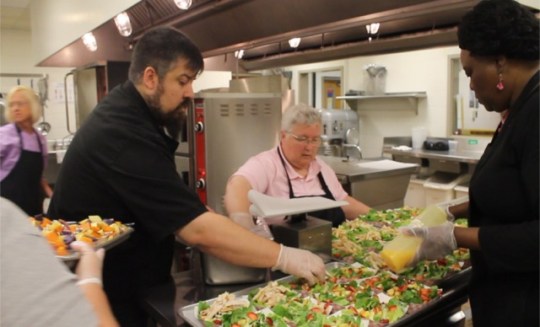Fresh, locally grown fruits, vegetables and meats are the emerging stars of school menus across Georgia.
“Farm to school [programs] and bringing local foods into the school has been increasingly popular over the last couple of years,” said Nancy Rice, state director of the Department of Education’s school nutrition division.
Some schools purchase produce from nearby farms while school is in session, Rice said, while a few contract with local farmers who freeze summer produce that can be used during the school year.
The Jackson County School System is doing more: Chef Josh Aaron is building special menus around Georgia-grown food. Aaron owns The Savory Spoon restaurant in Jefferson, where diners feast upon fresh and locally sourced ingredients.
On a chilly day in mid-April, all 12 schools in the district served a “Spring Salad with Chicken and Local Lettuces,” featuring Georgia-grown Bibb and Romaine lettuce and fresh chicken. Other ingredients included strawberries from North Florida, apples, Parmesan cheese and Italian dressing.
The chef himself strolled among the lunch tables at North Jackson Elementary School, an imposing but friendly presence.
“I’m there to talk to the kids about local produce and get them interested,” Aaron said. He wants the kids to know more about the food whether they actually like eating it or not.
Push from first lady
Meanwhile, healthy school lunches made national headlines this week, as first lady Michelle Obama vowed to fight industry efforts at rolling back federal standards.
A House bill up for consideration this week by the Appropriations Committee would allow schools to apply for waivers from the federally mandated standards if the school’s food program has recorded a financial loss for six months in a row, the Washington Post reported.
[youtube]http://youtu.be/LT0FR_XiIqo[/youtube]
Mrs. Obama urged health activists to fight agribusiness’s lobbying efforts to allow schools to opt out of the mandates to reduce sodium, increase whole grains, and increase servings of fresh fruits and vegetables in lunches.
In Jackson County, though, Chef Aaron wants to expose children to as many kinds of fruits, vegetables and fresh, unprocessed meats as possible. If kids broaden their tastes while they’re young, their “number one, go-to” food is less likely to be fried chicken fingers or nuggets, he said.
This is the second Georgia-centered meal the chef has created for local schools. The first featured slow-cooked pulled pork, braised collard greens, and carrots marinated in a citrus vinaigrette. The carrots and the collard greens were harvested in Georgia, and the meal was served to all 12 schools in the Jackson County school system in March.
The goal is for students to know and care where their food comes from and to appreciate “good, wholesome, non-processed foods,” said Debra Morris, nutrition director for the Jackson County School System.
If a child is asked to imagine a carrot, Morris wants them to visualize root vegetables that grow in soil and vary in size and color – not a plastic bag of uniform “baby” carrots milled by machines.
Similar efforts are under way throughout Georgia.
‘Feed My School’
The Georgia Department of Agriculture (GDA) sponsors a program called “Feed My School for a Week,” and schools vie to take part.
Recently announced 2014 participants are Annie Bell Clark Elementary in Tifton, Cave Springs Elementary in Rome, Claxton Elementary in Claxton, Commerce Primary School in Commerce and Mossy Creek Elementary in Cleveland.
For a week next spring, these schools will serve meals made mostly from Georgia-grown ingredients. GDA will help the schools create recipes and get local food. The schools will host guest speakers who will teach students about food and agriculture, and run contests and taste tests.
This 3-year-old program aims to improve the health of Georgia students by changing cafeteria menus and bringing farms and lunchrooms closer by helping schools with Farm to School initiatives.
Farm to School is a nationwide initiative that emphasizes not only buying food from local growers, but also teaching children to raise their own vegetables in school gardens. The Georgia effort is led by Georgia Organics, a nonprofit organization that promotes Georgia farms and locally grown food.
Georgia’s Farm to School program “was a little slow for the first two years back around 2007, but the demand is higher than ever,” said state director Erin Croom.
Only a few schools signed up at first, but when the U.S. Department of Agriculture conducted a national Farm to School census in 2011-2012, more than half of Georgia’s school districts (52 percent) were on board. Another 19 percent said they might join in the future.
Nationwide, just 43 percent of schools had Farm to School activities during the 2012-2013 school year, and only 13 percent were considering such programs.
Although Georgia’s programs look successful by comparison, they have room to grow. During the 2011–2012 school year, respondents spent close to $10 million on locally grown food, but their overall spending on food was close to $155 million. However, more than half of the schools (66 percent) said they plan to supply their cafeterias with more local food in the future.
In Jackson County, chef Aaron’s initiative is gathering momentum. Commerce City Schools have served his two local food menus to their students, and the Jefferson City School System may join next year.
The chef says there is much more work to do, and he doesn’t see his partnership with the schools ending any time soon. His plans include creating more and better menus for kids and a hub where local, certified naturally grown and organic farmers can send their produce for school distribution. Aaron has already spoken with farmers who are interested in supplying the schools, even if they just break even.
“We have a large group of local business [owners] who have a vested interest in these kids’ health and want to do whatever it takes to make them more energetic and successful in the classroom,” Aaron said in an email.
Putting fresh, locally grown food on the menu was just Aaron’s vision a year ago. Now that it’s become reality, he wants to see more fresh food coming down the cafeteria line. “We’re right on the first stepping stones of this work, “ Aaron said. “Now [we’ve] got the next steps to take.”
Hyacinth Empinado is a freelance science writer. She is currently a first-year graduate student in the health and medical journalism program at the University of Georgia.



